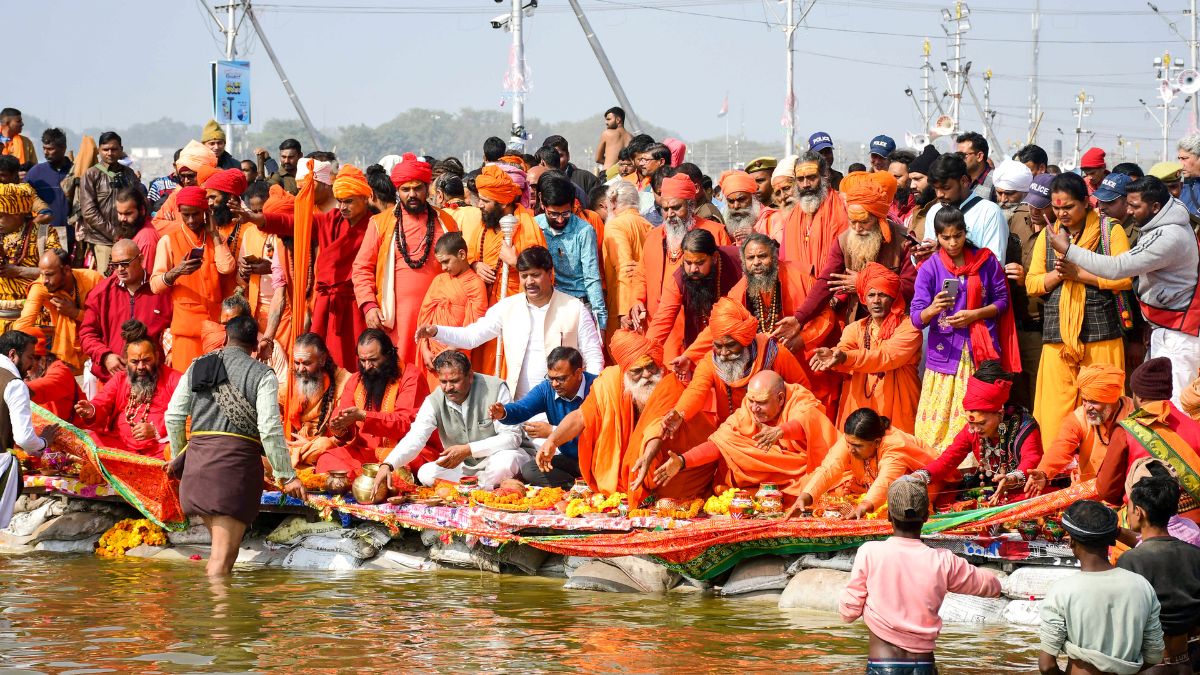‘Kumbh ke mele me bichde teen bhai… ab milenge ya nahi.’
You have probably heard the iconic dialogue from Manmohan Desai’s 1977 film Amar Akbar Anthony. Over the years, many films have referenced ‘Kumbh’ and ‘bichhadna’ (getting lost) since it is indeed common for people to lose track of loved ones in such large gatherings.
ALSO READ | Explained: Maha Kumbh and the multi-crore mela economy
This year, the Maha Kumbh Mela, one of the world’s largest and most significant religious events, is scheduled from January 13 to February 26, 2025. The event is expected to draw 450 million devotees, tourists, and pilgrims from around the world.
With such massive crowds, concerns about people, especially children, going missing naturally arise.
To address this, the administration has introduced an AI-powered computerised lost-and-found centre to help reunite missing children with their families amid the influx of pilgrims.
A daughter-in-law’s tearful search at the Mela
A viral video on social media captures a troubled woman crying at the mela grounds in Prayagraj. When bystanders ask her the reason for her distress, she explains that her mother-in-law has gone missing in the crowd.
In the video, a woman can be heard asking the crying daughter-in-law, “What has happened, why are you crying?" The sobbing woman replies that she had come to bathe in the Maha Kumbh with her mother-in-law, who is now lost in the massive gathering.
Impact Shorts
More ShortsThe bystanders are seen comforting her, assuring her that there is no need to worry. They suggest she make an announcement and remind her that the police are on hand to help locate her mother-in-law.
To prevent such incidents, the administration has implemented an AI-powered computerised lost-and-found centre to reunite families.
ALSO READ | Why Maha Kumbh Mela’s viral IIT Baba has been expelled from his akhara
How will this work?
AI-powered ‘Lost and Found’ centres at the Maha Kumbh Mela are revolutionising crowd management by reuniting individuals, particularly children, with their families.
The police have introduced AI tools that capture photographs of missing individuals and scan the crowd for facial matches, according to The Indian Express. Visitors are also encouraged to use the Kumbh app, which offers live tracking of companions.
Known as the ‘Khoya-Paaya Kendra,’ the centre in Sector 4 recently reunited two missing children, Dharamjeet (7) and Vikas Kumar (6), with their families. Found in separate areas on January 15, their photos were broadcast on digital platforms and TV screens across the fairgrounds, ensuring the information reached their families swiftly.
ALSO READ | All roads lead to Maha Kumbh: Rs 40,000 for stay, 162% jump in flight bookings to Prayagraj
Additional Mela Adhikari Vivek Chaturvedi told ANI, “An AI-based lost and found centre has been set up. Arrangements are made there for accommodation, clothes and food for the people who are lost… There has not been a single case in which we have not been able to reunite children or lost people with their relatives.”
“We have received a good response from the computerised lost and found centre… If there is a case in which we have not been able to reunite a person with his relatives, then the administration takes them to their home at its own expense."
‘Bhula-Bhatka’ centres
The opening day of the Maha Kumbh Mela, marked by the Paush Purnima bathing festival, saw millions gathering at the sacred Sangam. However, the dense crowd resulted in over 250 people becoming separated from their families within the first few hours.
Due to initiatives by the Uttar Pradesh government, including ‘Bhula-Bhatka’ camps, police assistance centres, and personnel stationed on watchtowers, those separated were quickly reunited, PTI reported.
These camps feature dedicated sections for women and children, alongside ‘Khoya-Paya’ centres equipped with digital tools and social media support. Loudspeakers along the ghats continuously announce missing persons’ names, facilitating faster reunions, while police and civil defence teams assist pilgrims on the ground.
Nitesh Kumar Dwivedi from Uttar Pradesh Civil Defence shared that hundreds of families were reunited on the first day alone. “Within the first one-and-a-half hours, we managed to bring around 200 to 250 individuals back to their families,” Dwivedi told PTI, adding that the crowd exceeded initial estimates.
Ajay Goyal, a pilgrim from Delhi, recounted his experience of being separated for an hour. “We had joked about how this often happens at Kumbh Melas in old Bollywood films. Fortunately, we were reunited quickly,” he said.
The UP government, in its official statement, discussed the success of ‘Khoya-Paaya’ centres, which are leveraging technology and social media platforms to locate missing individuals and ensure a smooth and secure experience for all attendees.
ALSO READ | Muscular, popular, and 7-foot-tall: Meet Russian Baba turning heads at Maha Kumbh 2025
Getting lost at Kumbh Mela: A common story
Over the years, countless stories have emerged of people getting separated from their loved ones during the vast gatherings of the Kumbh Mela.
Many attendees take precautions, such as carrying paper slips with their names and addresses written on them, to help others assist them if they get lost.
The theme of getting lost and eventually reuniting at Kumbh Mela has also found its place in Bollywood films.
Apart from the iconic Amar Akbar Anthony, the 1943 Nargis-starrer Taqdeer, directed by Mehboob Khan, features a Kumbh plot. In the film, a widower performing a play at the mela learns that his younger son, Pappu, is missing. Despite their search, they fail to find him.
The 2003 film Tujhe Meri Kasam, starring debutants Riteish Deshmukh and Genelia D’Souza, makes a light-hearted reference to Kumbh Mela with the line, “Kahin Kumbh ke mele mein to nahi bichhad gaye the? Aise ajnabi se kyun lagte ho?”
In Prayagraj, the Bharat Seva Dal has been tirelessly working to reunite missing individuals with their families during events like the Maha Kumbh, Ardh Kumbh, and Magh Mela. According to News18, the organisation has been consistently active during these gatherings.
With inputs from agencies
)